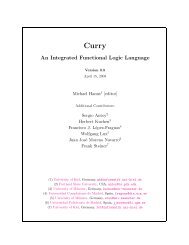Conformal Geometric Algebra in Stochastic Optimization Problems ...
Conformal Geometric Algebra in Stochastic Optimization Problems ...
Conformal Geometric Algebra in Stochastic Optimization Problems ...
Create successful ePaper yourself
Turn your PDF publications into a flip-book with our unique Google optimized e-Paper software.
2.3. EXTENDED CONCEPTS OF GA 69<br />
Hence the transformation of the whole is actually the transformation of its parts.<br />
What makes these properties so beneficial is, for <strong>in</strong>stance, that equations or rules<br />
may first be established <strong>in</strong> a simple coord<strong>in</strong>ate system and do then also hold <strong>in</strong> their<br />
reflected, rotated or translated versions. A case <strong>in</strong> po<strong>in</strong>t is the conformal geometric<br />
algebra, which is the subject of chapter 3.<br />
Make yourself aware of the possibility of versors act<strong>in</strong>g on versors. Let nV n be<br />
the reflection of the versor V <strong>in</strong> the unit vector n, n 2 = 1. The effect of the<br />
transformation ensemble may easily be <strong>in</strong>ferred writ<strong>in</strong>g<br />
(nV n)x(n � V n) = n(V (nxn) � V )n.<br />
So the action of V eventually takes place, but <strong>in</strong> a temporally different frame. It<br />
amounts to the same, but nV n can as well be <strong>in</strong>terpreted as the new modified<br />
versor V ′ . Let, for <strong>in</strong>stance V = v1v2 . ..vk, such that<br />
� �� �<br />
nV n = nv1v2 ...vkn = (nv1<br />
1<br />
n)(nv2n)...(nvkn) = v ′ 1v ′ 2 ...v ′ k = V ′ .<br />
Last but not least, when applied to a k-blade, the versor likewise transforms the<br />
dual of that blade<br />
V A 〈k〉 � V = V (a1 ∧ a2 ∧ . .. ∧ ak) � V<br />
= V (x1 ∧ x2 ∧ ... ∧ xn−k)I � V<br />
(2.49)<br />
= (−1) k(n−1) V (x1 ∧ x2 ∧ ... ∧ xn−k) � V I<br />
= (−1) k(n−1) V A ∗ 〈k〉 � V I, (2.57)<br />
where it was assumed that a1 ∧ a2 ∧ . .. ∧ ak = (x1 ∧ x2 ∧ ...xn−k)I.<br />
2.3.5 Subspace Considerations<br />
By the next couple of def<strong>in</strong>itions a phrase like ‘... x lies <strong>in</strong> A 〈k〉 ’ can be stated<br />
more precisely.<br />
Def<strong>in</strong>ition 2.16 ( Outer product null space):<br />
Given a blade A 〈k〉 ∈ �p,q, its outer product null space (OPNS) comprises all po<strong>in</strong>ts<br />
from � p,q that lie <strong>in</strong> the subspace represented by A 〈k〉 . The OPNS of A 〈k〉 , denoted<br />
by �er(A 〈k〉 ), is def<strong>in</strong>ed as<br />
�er(A 〈k〉 ) = {x ∈ � p,q |x ∧ A 〈k〉 = 0}.<br />
Strictly speak<strong>in</strong>g, the OPNS is supposed to be def<strong>in</strong>ed <strong>in</strong>dependently of the signature.<br />
It should, however, be clear that x ∈ �er(A 〈k〉 ), with x = � n<br />
i=1 xiei ∈ � p,q ,<br />
is equivalent to x ′ ∈ �er(A 〈k〉 ), where x ′ = � n<br />
i=1 xie ′ i ∈ �a,b , as long as a + b = n.<br />
�
















